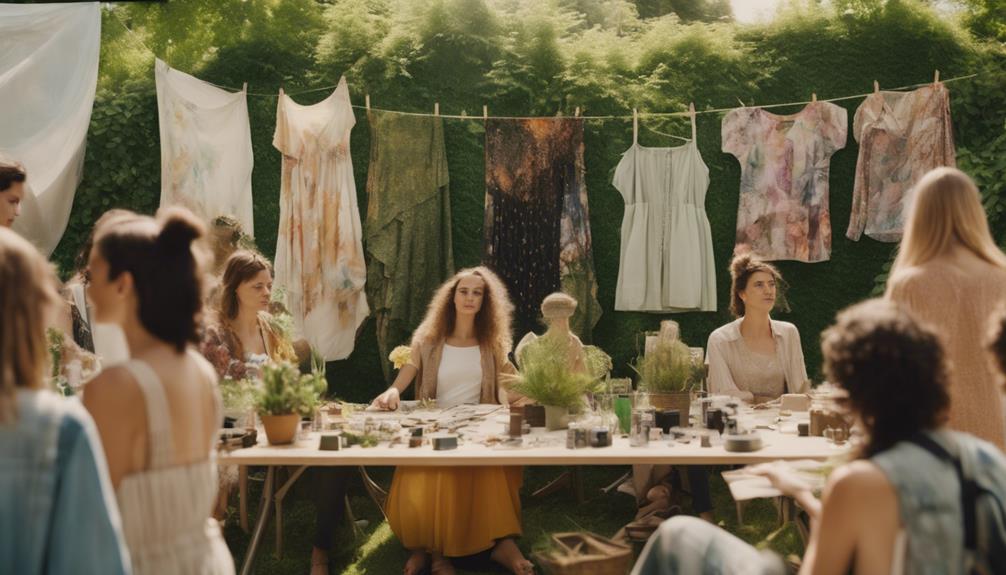The objective of sustainable fashion is clear and impactful: it strives to minimize environmental damage and advocate for ethical labor practices. By choosing brands that prioritize sustainability, you can contribute to a healthier planet. This movement not only addresses pollution but also advocates for fair wages and safe working conditions for garment workers. Opting for eco-friendly materials, such as organic cotton and recycled fabrics, helps support a circular economy that benefits everyone. Your choices can drive significant change in the fashion industry and pave the way for a fairer, more responsible future for all. There is much to discover on this journey! The purpose of sustainable fashion is to prompt consumers to be more conscious of their purchasing behaviors and the environmental impact. By backing sustainable fashion brands, you are conveying a message to the industry that you value transparency, ethical production, and environmental responsibility. Together, we can instigate meaningful change and shape a more sustainable and ethical future for the fashion industry.
Key Takeaways
- The primary goal of sustainable fashion is to reduce the environmental impact of the industry through eco-friendly materials and practices.
- It aims to ensure ethical labor practices, providing fair wages and safe working conditions for garment workers.
- Sustainable fashion promotes a circular economy, encouraging recycling and minimizing waste in clothing production and disposal.
- The movement seeks to raise consumer awareness about the importance of responsible consumption and its social and environmental consequences.
Understanding Sustainable Fashion
Sustainable fashion focuses on creating a clothing system that reduces environmental harm and supports ethical labor practices at every stage, from design to disposal. It addresses the significant environmental impact of the fashion industry, which is responsible for 20% of global industrial water pollution. By adopting resource conservation strategies, sustainable fashion aims to minimize this pollution and promote a healthier ecosystem.
As a consumer, you play a crucial role in this shift. The growing eco-consciousness among shoppers has led to a rising consumer base that actively seeks sustainable brands. In fact, 66% of consumers are willing to pay more for clothing that's produced ethically and sustainably.
This demand encourages brands to innovate and adopt more sustainable production techniques, focusing on biodegradable materials and responsible sourcing.
Importance of Sustainable Practices

Sustainable practices in fashion are essential for reducing the industry's significant environmental impact and promoting ethical labor standards.
By choosing sustainable options, you help combat pollution and support fair working conditions for those who create your clothes.
It's a simple way to make a positive difference in both the planet and people's lives.
Environmental Impact Reduction
Recognizing the fashion industry's considerable role in global greenhouse gas emissions, it's clear that adopting eco-friendly practices is essential for combating climate change. Sustainable fashion aims to minimize environmental impact through innovative approaches like circular fashion and the use of recycled materials. By implementing these practices, you can contribute to waste reduction and lower resource consumption.
| Issue | Impact | Solution |
|---|---|---|
| Greenhouse Gas Emissions | 10% of global emissions | Eco-friendly materials |
| Water Usage | 20% of industrial pollution | Shift to organic cotton |
| Waste Recycling | Only 3% recycled | Embrace circular fashion |
Shifting to organic cotton can reduce water usage by up to 91%, and using recycled materials can considerably cut down on resource consumption, saving oil and reducing carbon emissions. By prioritizing sustainable practices, you help create a more responsible industry. Remember, every purchase you make can drive change, pushing brands toward fair labor practices and eco-conscious decisions. Your choices matter in cultivating a healthier planet for future generations.
Ethical Labor Practices
Ethical labor practices are essential in the fashion industry, ensuring that workers receive fair wages and work in safe conditions, which can help combat exploitation and modern slavery. In sustainable fashion, brands prioritize these practices, advocating for living wages and better working environments for garment workers. The average garment worker makes only about $80 per month, emphasizing the urgent need for change.
By collaborating with certified factories, eco-ethical brands promote transparency throughout the supply chain, allowing consumers to see the origins of their clothes. This transparency fosters trust and encourages consumers to support brands committed to ethical labor practices. As consumer awareness grows through documentaries and advocacy campaigns, the demand for ethical standards in fashion increases.
When you choose to support eco-ethical brands, you're not just buying clothes; you're making a statement against exploitation and inequality. Each purchase can drive meaningful change, pushing the industry toward humane working conditions and fair treatment for all workers.
Embracing sustainable fashion isn't just about style—it's about standing up for the rights of those who create our garments and ensuring their dignity is upheld.
Key Principles of Ethical Fashion

At the heart of ethical fashion lies a commitment to fair labor practices, ensuring that workers are treated with dignity and compensated fairly. This approach prioritizes transparency in supply chains, allowing you to understand where your clothing comes from and the conditions under which it was produced. By choosing ethical fashion brands, you support Fair Trade principles that promote equitable trading conditions and sustainable livelihoods for marginalized producers.
Ethical fashion seeks to eliminate practices like modern slavery and exploitative labor, which often plague the fast fashion industry. By advocating for humane treatment of workers, it addresses the root causes of poverty and inequality. It encourages consumer awareness, empowering you to make thoughtful purchasing decisions that reflect your social values.
When you embrace ethical fashion, you're not just buying clothes; you're choosing a lifestyle that values responsibility and integrity. This shift in mindset fosters a community that cares about labor rights and the welfare of all involved in the fashion supply chain.
Environmental Consequences of Fashion

The fashion industry greatly impacts the environment, contributing to climate change and pollution through its production processes and material choices. With approximately 10% of global greenhouse gas emissions linked to fashion, it's clear that fast fashion's rapid cycle of production and disposal exacerbates environmental consequences. This model relies heavily on synthetic materials, leading to microplastic pollution, with around 500,000 tons of microfibers entering the oceans annually.
Moreover, textile production accounts for 20% of global industrial water pollution, as harmful chemicals from dyes and treatments contaminate waterways. The water footprint of conventional apparel is staggering—just producing a single cotton T-shirt requires about 2,700 liters of water. This excessive demand contributes to severe water scarcity issues.
Additionally, the industry's practices often result in deforestation, as land is cleared for raw material cultivation like cotton or livestock grazing.
Sustainable fashion brands are working towards a circular economy, aiming to reduce these environmental impacts by promoting eco-friendly materials and ethical production methods. By choosing sustainable options, you can help mitigate the harmful effects of the fashion industry and support a healthier planet.
Transitioning to Sustainable Models

Shifting to sustainable models demands real commitments from brands, pushing them to prove their dedication through meaningful actions rather than empty slogans. You'll notice that successful sustainable brands embrace ethical practices, focusing on the environment and improving working conditions. This isn't just about changing a few processes; it's a thorough change in how production is approached.
Collaboration plays an essential role in this changeover. Brands must work closely with clients, manufacturers, and distributors to develop sustainable practices that can be effectively implemented throughout the supply chain. While adopting sustainable models may come with higher design and production costs, these investments are significant. They guarantee fair wages and safe working conditions for workers, ultimately enhancing the brand's impact.
As consumers increasingly prioritize ethical and eco-friendly options, the demand for sustainable fashion is only growing. Brands that commit to this change not only meet consumer expectations but can also release significant growth potential.
Resources and assistance are readily available to support businesses in making these environmental shifts, covering every stage of production from ethics to packaging. Embracing sustainability isn't just a trend; it's a necessary evolution.
Social Impact of Sustainable Fashion

When you choose sustainable fashion, you're not just making a style statement; you're supporting fair labor practices that guarantee workers receive fair wages and safe working conditions.
You also empower communities by promoting brands that prioritize ethical production and social equity.
Together, your choices can help create a more just and equitable fashion industry.
Fair Labor Practices
Sustainable fashion champions fair labor practices by guaranteeing workers receive living wages and work in safe conditions. Ethical brands actively promote humane working conditions, highlighting the significance of transparency in their supply chains.
When you choose sustainable fashion, you're supporting efforts to combat modern slavery and poverty, as these brands often adopt fair trade practices that prioritize worker rights. Many garment workers in fast fashion earn as little as $80 a month, which underscores the urgent need for reform.
By demanding ethically produced clothing, you help drive awareness of labor conditions and encourage brands to improve their practices. This shift not only benefits individual workers but also fosters economic opportunities within their communities.
Sustainable fashion guarantees that the people behind your clothing are treated with dignity and respect. You play an essential role in this movement. Each purchase you make can contribute to a system that values fair labor practices and humane working conditions.
Community Empowerment
Community empowerment thrives in the domain of sustainable fashion, where ethical practices uplift garment workers and strengthen local economies. By ensuring fair wages and safe working conditions, you're not just supporting a trend; you're contributing to the well-being of individuals who create the clothes you wear.
Ethical sourcing plays an essential role here, as it fosters transparency in supply chains, allowing you to choose brands that prioritize social equity. When you support initiatives like Fair Trade certification, you help uplift marginalized communities, giving them access to markets and promoting sustainable livelihoods. This means that your purchasing decisions can directly impact the lives of those who've often been left behind in the global fashion industry.
Moreover, sustainable fashion encourages community engagement, bringing together brands, consumers, and local organizations to create a collective force for change. By participating in this movement, you're helping to build economic resilience and strengthen community ties.
Your choices matter, and they contribute to a larger narrative of community empowerment and social justice, ensuring that everyone involved in the fashion industry can thrive.
Innovations in Sustainable Materials

Innovative materials like ECONYL® and plant-based leathers are revolutionizing the fashion industry by offering eco-friendly alternatives that reduce environmental impact.
These innovations in sustainable fashion are key to addressing the urgent need for change in the textile sector. For instance, ECONYL® is made from recycled nylon, saving 70,000 barrels of oil and cutting down CO2 emissions greatly.
Plant-based materials, such as pineapple and mushroom leathers, provide cruelty-free options that repurpose waste, further lowering environmental impact. Similarly, recycled polyester, derived from plastic bottles, helps decrease reliance on virgin resources and minimizes landfill waste.
Organic cotton stands out as a sustainable alternative, requiring 91% less water than conventional cotton, which is a huge plus for resource conservation.
TENCEL™, crafted from sustainably sourced wood pulp, not only offers biodegradable properties but also employs a closed-loop process that effectively recycles water and solvents, reducing harm to the environment.
Tips for Sustainable Shopping

When you're shopping sustainably, start by researching brand practices to guarantee they align with your values.
Embrace timeless designs that won't go out of style, helping you reduce waste in your wardrobe.
Research Brand Practices
Researching brand practices is essential for making informed choices about sustainable shopping and supporting companies that prioritize ethical and eco-friendly methods. By examining a brand's commitment to sustainable fashion, you can align your consumer choices with your values.
Here's a quick guide to help you evaluate brand practices:
| Criteria | What to Look For | Why It Matters |
|---|---|---|
| Certifications | Fair Trade, Green America Certified | Guarantees ethical labor and environmental responsibility |
| Materials | Organic fabrics, recycled materials | Reduces environmental impact of your clothing choices |
| Transparency | Clear sourcing and production processes | Helps you trust the brand's eco-friendly claims |
Supporting local brands not only reduces carbon footprints associated with transportation but also fosters community engagement. When brands are transparent about their practices, you can feel confident that your purchases support ethical methods. Remember, your choices as a consumer can drive the demand for more sustainable practices in the fashion industry. So, take the time to research and choose wisely!
Embrace Timeless Designs
Choosing to embrace timeless designs not only elevates your wardrobe but also contributes greatly to sustainable shopping practices. By prioritizing classic styles, you're opting for quality items that last longer, reducing waste in the process. Fast fashion leads to excessive clothing turnover, but when you invest in versatile pieces that can be styled in multiple ways, you adopt a more conscious approach to fashion consumption.
Timeless designs help you combat the environmental impact of fast fashion, notably responsible for textile waste. Instead of chasing fleeting trends, focus on enduring styles that remain stylish year after year. This not only enhances your personal style but also aligns with the growing demand for sustainable fashion options.
Supporting brands that emphasize timeless designs shows your commitment to eco-friendly products, with 66% of shoppers willing to pay more for such items. By making thoughtful choices, you can curate a wardrobe filled with pieces that reflect your values and stand the test of time.
Embrace timeless designs, and watch how your sustainable shopping habits evolve, leading to a more responsible and stylish future.
Benefits of Choosing Sustainable Fashion

Opting for sustainable fashion not only minimizes your environmental footprint but also supports ethical labor practices and promotes innovative materials. By choosing sustainable clothing, you greatly reduce the environmental impact associated with the fashion industry, which accounts for 10% of global emissions and 20% of industrial water pollution. You're making a conscious decision that counters the exploitation often found in fast fashion, ensuring fair wages and safe working conditions for garment workers.
Sustainable fashion emphasizes the use of recycled materials and biodegradable alternatives, conserving natural resources and reducing fashion waste. For example, producing recycled polyester can save up to 70,000 barrels of oil for every 10,000 tons created. By prioritizing quality over quantity, you invest in long-lasting garments that require fewer purchases, thereby decreasing overall fashion waste.
Moreover, supporting sustainable brands fosters innovation in eco-friendly practices and materials, driving the industry toward a more responsible future. By embracing sustainable fashion, you not only enjoy unique, high-quality items but also contribute to a healthier planet and a fairer economy, making a positive difference with every purchase.
The Future of Fashion Sustainability

As consumer demand for transparency rises, the future of fashion sustainability looks promising, with brands increasingly adopting eco-friendly practices to meet ethical expectations.
More than ever, you're seeing companies invest in innovations like biodegradable fabrics and waterless dyeing techniques, aiming to reduce their environmental impact considerably. This shift is vital, especially considering the fashion industry accounts for up to 10% of global emissions, a figure projected to rise without meaningful change.
Regulatory changes are also on the horizon, pushing brands to comply with stricter environmental standards. Those that embrace sustainable fashion now will be better positioned to maintain market relevance in the future.
Community engagement and consumer education are essential in this change; as you become more aware of ethical practices, your choices promote responsible consumption patterns.
Ultimately, the future of fashion sustainability hinges on a collective effort to prioritize eco-friendly initiatives and transparency. By supporting brands committed to sustainable practices, you're not just making a fashion statement; you're actively participating in a movement that seeks to protect our planet for generations to come.
Frequently Asked Questions
What Is the Purpose of Sustainable Fashion?
The purpose of sustainable fashion is to reduce environmental impact and promote ethical practices. You support eco-friendly materials and fair labor conditions, helping create a more responsible industry that prioritizes both the planet and its people.
What Is the Goal of Eco Fashion?
Imagine a world where your wardrobe blooms like a garden. Eco fashion's goal is to nurture that world by minimizing waste, using sustainable materials, and ensuring fair labor, so you can wear your values proudly.
What Does Sustainability Mean to You in Fashion?
Sustainability in fashion means you prioritize eco-friendly materials and ethical production. It's about making conscious choices, reducing waste, and supporting brands that align with your values, ensuring a positive impact on the planet and society.
What Is Sustainable Fashion and Why Should We Care?
Sustainable fashion? Oh, who cares about that? You should, though! It minimizes pollution, promotes fair labor, and uses recycled materials. Your choices can drive change, helping the planet and ensuring better conditions for workers everywhere.
Conclusion
As you step into the world of sustainable fashion, you might wonder if your choices really make a difference.
But imagine a future where every garment tells a story of care and responsibility.
By embracing sustainable practices, you're not just dressing yourself; you're becoming part of a movement that could change the industry forever.
So, the next time you shop, ask yourself: what impact will your choices have?
The answer might just surprise you.









